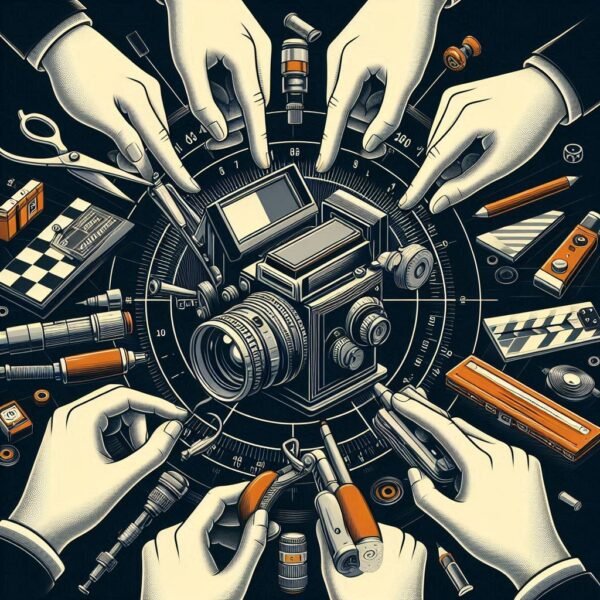Filmmaking Techniques: A Beginner’s Guide to Cinematography

Filmmaking Techniques: A Beginner’s Guide to Cinematography Techniques, Cinematic Techniques
Cinematography is a crucial aspect of filmmaking that encompasses various techniques and principles essential for creating visually compelling stories. This guide will introduce you to fundamental cinematography techniques, including key rules, shot types, and essential equipment.
Key Cinematography Rules
180 Degree Rule: This guideline helps maintain spatial relationships between characters by establishing an imaginary line. Crossing this line can confuse the audience regarding the orientation of the scene.
Rule of Thirds: This composition technique divides the frame into nine equal sections, allowing filmmakers to place important elements at the intersections of these lines for a balanced and engaging shot.
Mise en Scène: This French term refers to everything within a scene, including props, lighting, and actors’ positioning. Proper arrangement enhances the storytelling aspect of a film.
Basic Cinematography Techniques
Close-Up: A shot focusing closely on a subject, typically from the shoulders up. This technique connects viewers emotionally with characters.
Extreme Close-Up: This shot zooms in on a specific detail, such as an eye or hand, emphasizing small but significant elements in the narrative.
Long Shot: Captures a subject from a distance, providing context within the environment. It often includes the entire body of the character.
Extreme Long Shot: Similar to a long shot but taken from an even greater distance, establishing the character’s relationship with their surroundings.
Tilt and Pan Shots: A tilt shot moves the camera up or down on a vertical axis, while a pan shot swivels left or right on a horizontal plane. Both techniques are used to guide audience attention within a scene.
Tracking Shot: This involves moving the camera alongside a subject as they move through space, creating a dynamic sense of motion.
Crane Shot: Taken from a crane, this shot allows for sweeping movements and unique angles that add drama to scenes.
Essential Equipment and Tools
Storyboards: These visual representations outline each shot’s composition and sequence, serving as a roadmap for filming.
Shot Lists: Detailed lists that specify every shot needed for production, including camera angles and lighting setups to ensure comprehensive coverage during filming.
Lighting Techniques
Lighting is fundamental in cinematography as it sets the mood and tone of scenes. Understanding how to manipulate light can significantly impact storytelling:
High-Key Lighting: Bright and even lighting that minimizes shadows; often used in comedies.
Low-Key Lighting: Creates dramatic contrasts with deep shadows; commonly used in thrillers or horror films.
Mastering these cinematography techniques will provide beginners with the foundational skills needed to create visually compelling films. By understanding composition rules, various types of shots, and effective lighting strategies, aspiring filmmakers can enhance their storytelling capabilities and engage audiences more effectively.
Filmmaking is a complex process, but understanding the basics of cinematography and cinematic techniques can help you create compelling visuals for your films.
Cinematography is the art of visual storytelling with images. It encompasses everything from camera angles and movement to lighting and composition.
Cinematic techniques are specific methods used to achieve certain effects in a film. These can include anything from using slow motion to create a dramatic moment to using a specific camera angle to make a character look powerful.
Here are some basic cinematography techniques that every beginner should know:
Camera angles: The angle at which the camera is positioned can have a big impact on how the audience perceives a scene. For example, a low-angle shot can make a character look powerful, while a high-angle shot can make them look vulnerable.
Camera movement: The way the camera moves can also affect the mood of a scene. For example, a slow pan can create a sense of suspense, while a fast zoom can create a sense of urgency.
Lighting: Lighting is essential for creating the right mood in a scene. For example, bright lighting can make a scene feel happy and upbeat, while dark lighting can make it feel mysterious and suspenseful.
Composition: The way the elements of a scene are arranged can also affect how the audience perceives it. For example, using the rule of thirds can create a more visually appealing composition.
In addition to these basic techniques, there are many other cinematic techniques that you can use to create different effects in your films. These include:
Slow motion: Slow motion can be used to create a dramatic moment or to emphasize a particular action.
Fast motion: Fast motion can be used to create a sense of urgency or to make a scene more comedic.
Time-lapse: Time-lapse can be used to show the passage of time or to create a sense of wonder.
Special effects: Special effects can be used to create anything from explosions to fantastical creatures.
As you become more experienced in filmmaking, you will learn how to use these techniques to create your own unique style.
Here’s a beginner’s guide to filmmaking techniques covering cinematography and cinematic techniques:
Filmmaking Techniques: A Beginner’s Guide to Cinematography and Cinematic Techniques
1. Introduction to Cinematography
Cinematography is the art of visual storytelling in filmmaking. It involves composing shots, controlling lighting, and using movement to create emotion and meaning. The cinematographer (or Director of Photography) works closely with the director to bring the film’s vision to life.
2. Camera Shots & Angles
a) Basic Camera Shots
Wide Shot (WS): Establishes the setting and shows characters in context.
Medium Shot (MS): Frames the subject from the waist up, often used for dialogue scenes.
Close-Up (CU): Focuses on a subject’s face or a key detail, enhancing emotion.
Extreme Close-Up (ECU): Highlights a specific detail, such as eyes or hands.
b) Camera Angles
Low Angle: The camera looks up at the subject, making them appear powerful.
High Angle: The camera looks down, making the subject seem vulnerable.
Over-the-Shoulder (OTS): Commonly used in conversations, showing one character’s perspective.
Dutch Angle: A tilted shot creating a sense of unease or tension.
3. Camera Movement
Static Shot: The camera remains still, focusing attention on the subject.
Pan & Tilt: Side-to-side (pan) or up-and-down (tilt) movement for dynamic framing.
Tracking (Dolly) Shot: The camera moves with the subject, often on a dolly or stabilizer.
Handheld: Creates a raw, immersive feel, often used in action or documentary films.
Crane/Jib Shots: Sweeping movements from high to low perspectives, adding dramatic effect.
4. Lighting Techniques
Three-Point Lighting:
Key Light: Main source of light.
Fill Light: Softens shadows.
Backlight: Creates depth and separation from the background.
High-Key Lighting: Bright, even lighting, often used in comedies or commercials.
Low-Key Lighting: High contrast and deep shadows, common in thrillers or horror films.
Natural Lighting: Uses available light sources for a realistic look.
5. Composition & Framing
Rule of Thirds: Divides the frame into a 3×3 grid for balanced composition.
Leading Lines: Uses natural lines to draw attention to the subject.
Depth of Field: Controls focus, using shallow DOF for subject emphasis and deep DOF for broader focus.
Negative Space: The empty areas around a subject to create mood or isolation.
6. Cinematic Storytelling Techniques
Montage: A series of shots edited together to show passage of time or build emotion.
Match Cut: Seamlessly transitioning between two similar shots.
Long Take: An extended, uninterrupted shot that builds tension or immersion.
Slow Motion/Fast Motion: Alters time perception for dramatic effect.
Mastering cinematography techniques takes practice, experimentation, and an understanding of how visuals impact storytelling. Whether you’re shooting on a phone or a professional camera, applying these principles can elevate your filmmaking.
